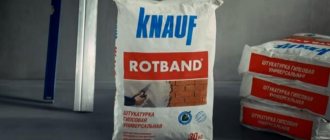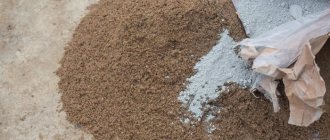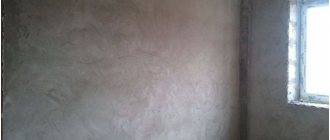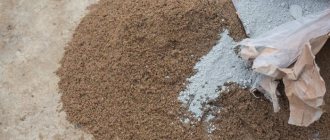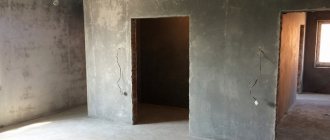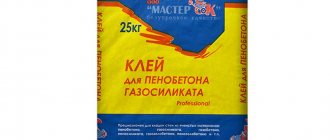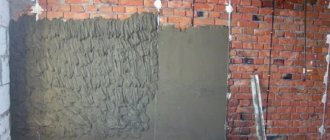Carrying out finishing work in an apartment often includes leveling the walls using plastering. In order to determine in advance the amount of material to be purchased, you need to know the consumption of plaster required for this operation. Such awareness will help not only to avoid downtime caused by a lack of dry mixture, but also to avoid unnecessary costs. Hired workers, wanting to earn extra money, often overestimate the amount of dry mixture consumed, and such a calculation will bring them to clean water.
Important! To calculate the consumption of plaster that will be required to obtain a flat surface, it is not enough to simply multiply the consumption of the dry mixture per 1 m2 indicated on the bag with the plaster mixture by the area of the wall being treated. In the calculation, parameters such as the curvature of the walls and the type of material used for plastering should be taken into account.
Determining layer thickness
To make a preliminary calculation and find out how much material is required per square meter of coating, you need to determine the thickness of the plaster to be applied. To do this, the first thing you need to do is clean the wall surface as thoroughly as possible.
Smooth walls in apartments, especially those built during the Soviet period, are quite rare. To find out the deviation of the wall, you should level several beacons on it. The layer thickness is calculated as follows:
- The deviation from the plane is measured for each beacon.
- All results are summed up and divided by the number of measurements. The resulting value will be the average layer thickness, on which the consumption of plaster required to level the available square meters of wall will depend.
For example, you need to plaster a wall with an area of 12 m2 with a maximum deviation of 6 cm. Four beacons were installed that showed deviations of 1.2, 4 and 5 cm. The average layer thickness in this case is found as the arithmetic mean:
(1+2+4+5)/4=3 cm.
In old apartments, there are often cases when the walls are filled unevenly, and installing beacons will be quite difficult. But otherwise it is not possible to calculate how much material is required for each square meter of surface.
In new buildings, walls rarely deviate from the vertical plane by more than 20–25 mm. In these cases, a thin leveling layer will be required, therefore, the consumption of plaster per 1 m2 will be small.
Note! In any case, the thickness of the layer cannot be less than the thickness of the beacon. The standard beacon profile has a thickness of 6 mm, and this should be taken into account when calculating the required amount of plaster mixture.
Budgeting
Renovating an apartment is a necessary and very responsible task.
It is impossible to do without certain professional knowledge and skills in practical work here. Repair work should be entrusted to specialists, and it is recommended that you do the calculation yourself. However, it is not prohibited to seek advice from a person with practical experience in the field of apartment renovation. To understand how much material is needed, it is first recommended to determine the curvature of the walls. To do this, you should thoroughly clean the surface from old wallpaper, dirt and dust, pieces of old plaster, and also tap it with a hammer to identify hollow fragments, and then attach a perfectly flat two-meter lath or bubble level to it. The normal deviation even for vertical planes 2.5 meters high can be up to 3-4 cm. Such facts are not unusual and occur quite often, especially in buildings of the 60s of the last century.
It is also important to determine which plaster mixture will be used: gypsum or cement. The difference in prices for different construction compounds is quite significant, and for the work you will need more than one or two bags.
So, in order to calculate with a good approximation the consumption of plaster for each specific wall, you should decide how thick the layer of this plaster itself will be.
Dependence of mixture consumption on the type of plaster
Having determined the average size of the leveling layer, you can calculate the required amount of material depending on the type of plaster mixture used. The packaging must indicate how much material is required to form a leveling layer of 1 cm on a surface of 1 m2. This value should be multiplied by the average thickness of the plaster obtained earlier and by the number of square meters of surface to be leveled.
USEFUL INFORMATION: How long does it take for the plaster on the walls to dry completely?
Characteristics of various types of plasters and approximate consumption rates
Each type of plaster mixture has its own characteristics, and the material consumption per 1 m2 of surface can vary significantly.
- Gypsum is durable, dries quickly, very easy to use, but in most cases it is not suitable for wet rooms. Approximate consumption – 9 kg per square meter with a thickness of 1 cm.
- Cement is universal, moisture resistant, can be applied to concrete, brick and even old plaster. Suitable for any room, including the bathroom, kitchen and open balcony. The highest consumption is 17 kg/m2.
Working with cement mortar is quite difficult, so many owners prefer to trust specialists who offer services for applying plaster mortar by machine.
What regulatory documents should be used when calculating
Standards for plastering walls were drawn up a long time ago and over the years have been repeatedly tested in practice by many builders. To determine the material consumption per 1 m2, only 2 regulatory documents are required, namely:
- SNiP 3.04.01-87. The standards have been drawn up specifically to determine the thickness and quality of both insulating and finishing coatings.
- Standard indicators of material consumption (NPRM) Collection 15.02 Plastering works. The collection is quite extensive and is recommended by the State Construction Committee of Russia as information material for the development of construction estimates. Standards and types of finishing materials for any surface are given.
Many of the data specified in SNiP 3.04.01-87 or in the more current version SP 71.13330.2017 are also in NPRM, but in an abbreviated version. No more regulatory documents are required to calculate consumption.
Knauf Rotband
“Rotband” is a popular, affordable and high-quality gypsum mixture, optimal for application by hand. The thickness of the layer should not exceed 5 cm. The amount required to treat 1 m2 with a layer of 1 cm is 8.5 kg.
Buy Knauf Rotband in the online store
Anton Tsugunov , I have been doing repairs and finishing since 2003.
I prefer to buy plaster in an online store - it is very simple, convenient and safe. You can buy plaster without leaving your home. Most often I order delivery directly to the site, so as not to waste time and not “damage” the car.
In the online store you can find the exact specifications and real customer reviews.
Moreover, when I pay for the tiles with my card , I receive cashback of up to 30% of the purchase amount!
It turns out to be a double benefit! I don’t risk my health, I don’t waste time on the road, I receive the paid tiles at the time I specified and also save up to 30%.
Plaster is packaged in 30, 10 and 5 kg
Volma Layer
“Volma” is another plaster widely known in finishing circles, high-quality and inexpensive. A cement-based composition is used for rough leveling; material consumption reaches 12 kg/m2. Volma gypsum plaster mixture is used for treating walls and ceilings for painting or wallpapering and does not require subsequent puttying. Consumption – 8–9 kg/m2.
USEFUL INFORMATION: How and with what to paint the lining?
Gypsum plaster “VOLMA-Sloy” is intended for finishing finishing work manually indoors. It perfectly fills potholes and helps smooth out uneven walls, as it can be applied in a layer of 5 to 60 millimeters. After drying, the composition forms an even layer of white color on the surface, which does not require subsequent puttying. This mixture is compatible with a wide range of building materials. You can buy it for application to brick, concrete, aerated concrete, etc.
Advantages:
- Versatility.
- Resistant to cracking.
- Affordable price.
- Easy to apply.
About gypsum and its range of applications
Gypsum has a wide range of uses due to its chemical base of calcium sulfate dihydrate.
It has been known as a building material since ancient times. An improved process scheme for processing raw materials (gypsum stone) is currently in use.
Sedimentary rock has several types of structure:
- crystalline;
- fibrous;
- grainy;
- sandy.
In the bowels of the earth, gypsum deposits are continuous masses that look like marble, lamellar, glassy, needle-shaped, silky accumulations and crystals.
Work requires attention
The color of gypsum can have warm honey shades, as well as white and grayish colors.
In order to transform the mined rock into the initial component of building compositions, it is necessary to carry it through several operations:
- crushing using hammer devices;
- the operation of grinding gypsum crushed stone into powder is combined with the process of its heat treatment (drying);
- at the stage of its firing in the temperature range of 130–160 degrees Celsius. Within 1–3 hours, a semi-aqueous powder is obtained. What specific time interval to choose is up to the technologists to decide.
Gypsum is used not only in the form of a calcined mineral. The raw mineral is used by sculptors to create sculptures and crafts, in the production of Portland cement, and in agriculture as a fertilizer.
Before work
The scope of application of the mineral, which has undergone special processing, is enormous: it is used in construction, architecture, medicine, in the production of cement and paper, and in the manufacture of stucco. Burnt gypsum has proven itself especially well as a material for the production of various types of gypsum plasters.
Gypsum plaster Knauf Iceberg
Knauf Eisberg gypsum plaster is used for leveling walls and ceilings in dry rooms, repair and restoration work. The material is universal and does not require subsequent puttying. The main component of the building mixture is high-quality gypsum, which is an environmentally friendly and lightweight material.
Consumption: 8.5 kg
Gypsum plaster cannot be used in conditions of high humidity, otherwise it is universal and can be used for different substrates:
- concrete of different structures (dense and cellular);
- cement plaster;
- stone and brick;
- expanded polystyrene and DSP.
Advantages of gypsum plaster
The material “breathes”, regulates the amount of moisture in the air, absorbing it when there is excess and releasing it when there is a deficiency. Creates a favorable indoor microclimate.
The mixture is plastic and easy to apply; it is easier to work with than other types of plaster. The coating provides good heat and sound insulation. The consumption of gypsum mixture is significantly lower compared to cement.
Packaged 30 kg
Gypsum plaster Unis Teplon
White gypsum plaster "UNIS Teplon" is suitable for interior decoration of walls and ceilings. After drying, it forms a smooth, glossy surface and does not require the application of putty. The perlite included in the mixture makes it light and increases the heat-shielding characteristics.
Material Features:
- Suitable for sealing seams and cracks up to 7 cm in depth.
- The layer when applied without a mesh on the wall is up to 5 cm.
- The layer when finishing the ceiling is up to 3 centimeters.
- The solution must be used within 50 minutes.
- Consumption when applying a layer of 1 cm is up to 10 kilograms per square meter.
USEFUL INFORMATION: Do I need to prime the walls before painting: do I need a primer
Advantages of gypsum plaster "UNIS Teplon":
- Easy.
- Sets within 3 hours.
- Breathing.
- Does not require application of an additional finishing layer.
- Resistant to cracks.
Packaging 30 kg
Important nuances
When mixing the gypsum mixture, you must remember that its drying time is very short, about 20 minutes, during which time you need to have time to apply it. That is why a small bucket is used to mix such compositions, which is not completely filled with the composition.
For decorative mixtures, the setting period is even shorter.
When purchasing material, you should always focus on a larger quantity, since the consumption will be greater than calculated. The mixture remains on the application tools, in the container, and may become unusable during application, which is why it will have to be mixed again. Typically, it is best to purchase an additional 5-10% in addition to the calculated volume. Consumption will increase if there are many cracks in the wall.
About Knauf Rotband plaster and the features of its consumption, see the following video.
Final calculation of the required amount of material
Using the data on the packaging, it is easy to calculate the amount of dry mixture that needs to be purchased.
So, for our example with a wall with an area of 12 m2 and a calculated average layer thickness of 3 cm, when using gypsum plaster we get:
3 x 9 x 12 = 324 (kg)
- If the dry mix is supplied in 30 kg bags, you will need to purchase 11 bags.
- For packaging 25 kg - 13 bags.
- For material in 50 kg bags - 7 pieces.
- You will need to buy 33 small 10-kilogram packages.
It is better to buy consumables with a small supply, so that you do not have to make an emergency trip to the store if just a little of the plaster mixture is not enough. And the material from the required manufacturer may simply not be available. It is better to buy an extra bag; the excess can always be used elsewhere.
Thus, having correctly made all the calculations, you can decide on the required budget for repair work, the amount of material purchased and not spend extra money.
How to use the calculator?
If you have any difficulties with the calculations, you can use our calculator:
- Specify the length and height of the walls. Use the comma symbol as the decimal separator.
- Specify the thickness of the plaster and putty layer in millimeters. To calculate the thickness, use our algorithm, which is indicated in the first paragraph of the article (calculation using a 4-point suspension).
- Now select the type of plaster or putty. At the end, click the “Calculate” button and get the results.
As you can see, using the calculator for calculations is quite simple, and anyone can handle it. However, you should understand that the calculator is approximate, so it is recommended to take putty or plaster with a small margin.

